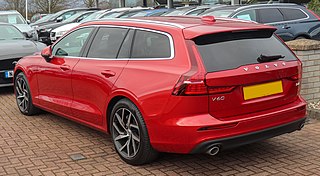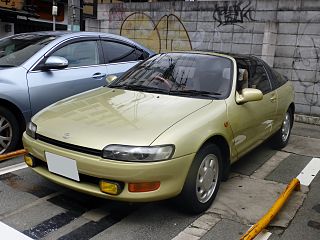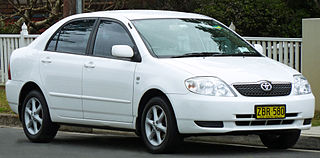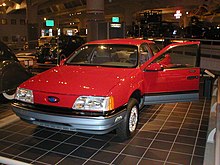
A station wagon or estate car, is an automotive body-style variant of a sedan with its roof extended rearward over a shared passenger/cargo volume with access at the back via a third or fifth door, instead of a trunk/boot lid. The body style transforms a standard three-box design into a two-box design—to include an A, B, and C-pillar, as well as a D-pillar. Station wagons can flexibly reconfigure their interior volume via fold-down rear seats to prioritize either passenger or cargo volume.

A hatchback is a car body configuration with a rear door that swings upward to provide access to the main interior of the car as a cargo area rather than just to a separated trunk. Hatchbacks may feature fold-down second-row seating, where the interior can be reconfigured to prioritize passenger or cargo volume.

A coupe or coupé is a passenger car with a sloping or truncated rear roofline and two doors.

The Honda Accord, also known as the Honda Inspire in Japan and China for certain generations, is a series of automobiles manufactured by Honda since 1976, best known for its four-door sedan variant, which has been one of the best-selling cars in the United States since 1989. The Accord nameplate has been applied to a variety of vehicles worldwide, including coupes, station wagons, hatchbacks and a Honda Crosstour crossover.

A suicide door is an automobile door hinged at its rear rather than the front. Such doors were originally used on horse-drawn carriages, but are rarely found on modern vehicles, primarily because they are less safe than a front-hinged door. Being rear-hinged, if the vehicle was moving and the door opened, aerodynamic drag would force the door open, and the driver/passenger would have to lean forward and out of the vehicle to close it. As seat belts were not in common use at that time, the risk of falling out of the car and into traffic was high, hence the name "suicide door".. Another reason could have been that while a door was open on a city street, a speeding car moving in the same direction as the parked car could rip a front-hinged door off the parked car but someone in side the adjacent seat, even if moving to leave the car, could not get scratched. However, with a suicide door, someone inside or partially outside the passenger compartment would get struck by the suicide door forcefully swinging back to a shut position due to the impact of the speeding car.
A child safety lock is a special-purpose lock for cabinets, drawers, bottles, etc. that is designed to help prevent children from getting at any dangerous things or contents. Young children are naturally curious about their surroundings and will always explore, but as they may be unaware of dangerous substances or situations, the results can be fatal. Numerous cases of poisoning have resulted from eating brightly colored pills or spilling cleaning solvents.
There are many types of car body styles. They vary depending on intended use, market position, location, and the era they were made.

The Saturn S-series is a family of compact cars from the Saturn automobile company of General Motors. Saturn pioneered the brand-wide "no-haggle" sales technique.

A liftback is a variation of a hatchback car body style, with a more gently sloping roofline, roughly between 45 and 10 degrees, whereas traditional or archetypal hatchback designs tend to use a 45 degree to near vertical slope on the top-hinged tailgate.

In the automotive industry, a gull-wing door, also known as a falcon-wing door or an up-door, is a car door that is hinged at the roof rather than the side, as pioneered by Mercedes-Benz 300 SL, first as a race car in 1952 (W194), and then as a production sports car in 1954.

The Toyota Sera is a 3-door 2+2 hatchback coupe manufactured and marketed by Toyota from 1990 to 1996. It was only officially sold in Japan.

The trunk or boot of a car is the vehicle's main storage or cargo compartment, often a hatch at the rear of the vehicle. It can also be called a tailgate.

Scissor doors are automobile doors that rotate vertically at a fixed hinge at the front of the door, rather than outward as with a conventional door.

The pillars on a car with permanent roof body style are the vertical or nearly vertical supports of its window area or greenhouse—designated respectively as the A, B, C and D-pillar, moving from front to rear, in profile view.
A glossary of terms relating to automotive design.

Quarter glass on automobiles and closed carriages may be a side window in the front door or located on each side of the car just forward of the rear-facing rear window of the vehicle. Only some cars have them. In some cases, the fixed quarter glass may set in the corner or "C-pillar" of the vehicle. Quarter glass is also sometimes called a valence window.

The Toyota Corolla (E120/E130) is the ninth generation of compact cars sold by Toyota under the Corolla nameplate. In Japan, this series arrived to the market in August 2000; however, exports were typically not achieved until 2001 and 2002 depending on the market.

The sixth-generation Honda Civic is an automobile produced by Honda from 1995 until 2000. It was introduced in 1995 with 3-door hatchback, 4-door sedan and 2-door coupe body styles, replicating its predecessor's lineup. The sixth-generation Civic offered two new 1.6-liter 4-cylinder engines and a new continuously variable transmission (CVT) on the HX model. The coupe and sedan are 2.3 in (58 mm) longer and the hatchback is 4.3 in (109 mm) longer than the previous-generation Civic. This was the last generation of Civic to have front double-wishbone suspension, as the succeeding seventh generation would change the front suspension to a MacPherson strut.
The VAM Lerma is an automobile that was designed and manufactured by Vehiculos Automotores Mexicanos from 1981 to 1983. The Lerma shared parts with other vehicles by VAM's license partner American Motors (AMC) to reduce manufacturing costs. It was VAM's top-of-the-line flagship model after the discontinuation of the Classic (Matador) line in 1976. The VAM Lerma was unusual in offering a hatchback design focused at the top-end luxury market. The model was an indirect replacement of the VAM Classic and to some extent the VAM Pacer lines.


















